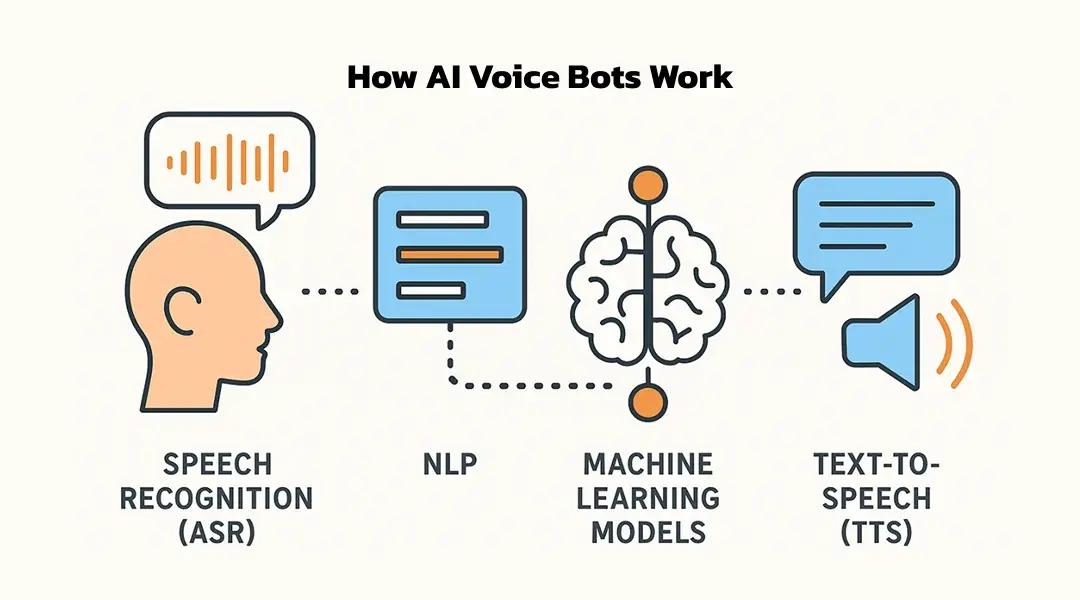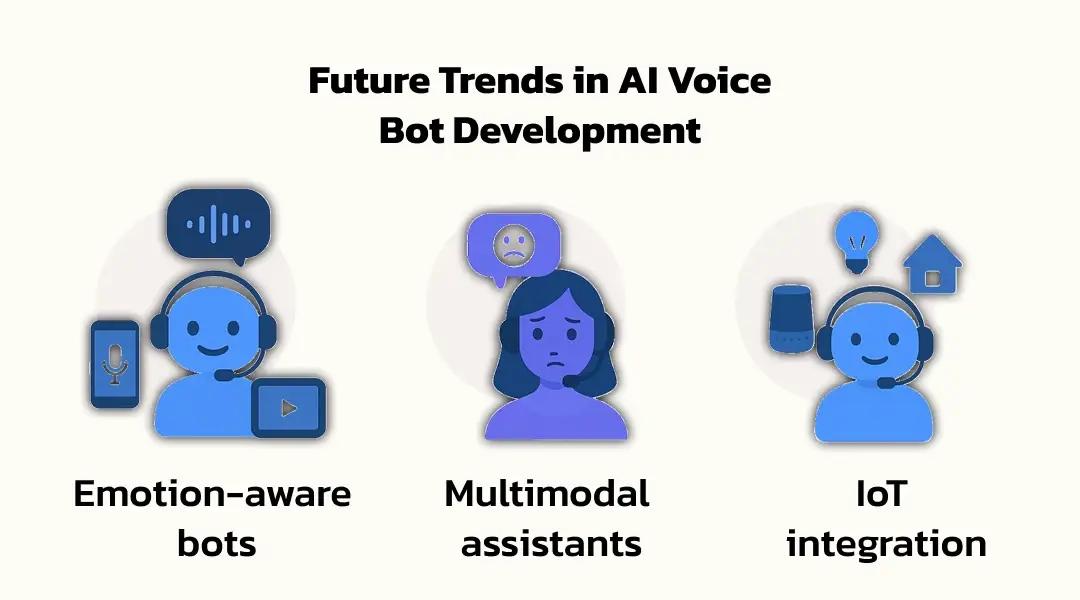The Ultimate Guide to Developing AI Voice Bots
I’ll be blunt: customers hate waiting. Whether it’s a 20-minute call queue or a chatbot that spits out useless canned replies, patience has run out.
That’s where AI voice bots come in. Businesses aren’t asking if they should use them anymore. The question in 2025 is how fast can we implement them before competitors do?
From e-commerce giants to local clinics, AI voice automation is reshaping customer service, sales, and operations. And no—it’s not hype. I’ve personally seen AI voice assistants reduce call-center costs by 40% while actually improving customer satisfaction.
What is an AI Voice Bot?
Think of an AI voice bot as a digital employee that talks like a human, listens like a human, and answers questions instantly. Unlike basic chatbots that rely on pre-scripted text, AI voice bots use speech recognition and natural language processing (NLP) to understand real conversations.
Difference between AI voice bots, chatbots, and voice assistants:
Chatbots: Text-only, often rule-based, limited context.
Voice Assistants (like Alexa/Siri): General-purpose, consumer-focused.
AI Voice Bots: Business-focused, built for customer interactions, sales, and service calls.
Core Technologies Powering AI Voice Bots:
NLP (Natural Language Processing)
Speech-to-text (Automatic Speech Recognition – ASR)
Machine learning models for intent detection
Text-to-speech (TTS) for natural responses
Key Benefits of AI Voice Bots for Businesses
24/7 availability & reduced costs: No holidays. No sick days. No “please hold.” AI voice bots handle queries round the clock—at a fraction of the cost of traditional support teams.
Personalized customer experience: Bots don’t just answer; they remember. With CRM integration, they can greet repeat customers by name and tailor responses based on past purchases.
Scalability for high-volume operations: Got 5 calls? Or 5,000? Voice bots scale without hiring sprees. I’ve seen startups handle Black Friday-level traffic without breaking.
Multilingual support: India alone has 22 official languages. AI voice automation makes businesses accessible in Hindi, Tamil, Telugu, Bengali—and beyond.
How AI Voice Bots Work: The Technology Behind Them

Here’s the simple breakdown (because the tech is complex, but your understanding doesn’t have to be):
Speech Recognition (ASR): Converts spoken words into text.
NLP: Interprets meaning, intent, and context.
Machine Learning Models: Decide the “best” response based on training data.
Text-to-Speech (TTS): Converts the AI’s decision back into natural-sounding voice.
And yes, these steps happen in milliseconds.
Industries Using AI Voice Bots
E-commerce & Retail: Automated order tracking, upselling, cross-selling.
Healthcare: Appointment booking, prescription reminders, insurance queries.
Banking & Financial Services: Balance inquiries, fraud detection, loan updates.
Travel & Hospitality: Flight bookings, cancellations, real-time itinerary changes.
Education & E-learning: Course guidance, student support, multilingual tutoring.
Step-by-Step Guide to Developing an AI Voice Bot
Define business goals & use cases – Sales? Support? Lead qualification? Clarity here saves you money later.
Choose the right platforms – Google Dialogflow, Amazon Lex, Microsoft Bot Framework, OpenAI APIs, or a custom-built solution.
Design conversation flows – Map out likely user queries and design responses that feel natural.
Train AI models with real-world data – The bot learns from actual customer interactions.
Integrate with CRM, call centers, and apps – Otherwise, it’s just a toy.
Testing & deployment – Test accents, noise levels, and edge cases.
Continuous improvement – AI isn’t “done.” You refine as customer behavior evolves.
AI Voice Bot Development Best Practices
Human-like conversations: Avoid robotic monotone; train for natural pauses and empathy.
Error handling & fallback: No bot is perfect. Always design a graceful handoff to human agents.
Data security & compliance: Especially in healthcare and banking. GDPR, HIPAA, RBI guidelines—all matter.
Accent & language optimization: An Indian customer in Chennai won’t speak like one in Delhi. Train accordingly.
AI Voice Bots vs Traditional Chatbots
Chatbots: Good for FAQs and text-based support. Voice Bots: Critical for real-time, complex, emotional interactions.
If your customers need speed + empathy, voice wins. If they just need a quick link, a chatbot might suffice.
Future Trends in AI Voice Bot Development

Emotion-aware bots: Detecting tone, stress, and mood to respond with empathy.
Multimodal assistants: Voice + video + text blended in one interaction.
IoT integration: Imagine your fridge booking milk when you say “running low.”
How to Choose the Right AI Voice Bot Development Company
This is where most businesses trip up. You don’t just need coders. You need a partner who understands your industry, customer psychology, and compliance requirements.
Questions I’d ask any AI voice bot development company:
Do you customize solutions or resell templates?
How do you handle multilingual training?
Can you integrate with my existing CRM and apps?
What’s your process for ongoing improvement?
(And yes, KriraAI does all of this. But don’t take my word—always vet your options.)
Conclusion
AI voice bots aren’t “the future.” They’re the present. And businesses dragging their feet are already losing customers to competitors who sound more human, more responsive, and more available.
The good news? You don’t need to be a Fortune 500 to start. With the right approach, even a growing startup can implement AI voice automation that feels natural, reliable, and—dare I say—better than a human agent in some cases.
FAQs
Costs vary—from $5,000 for a simple bot to $50,000+ for enterprise-grade solutions with multilingual support and CRM integration.
Chatbots are text-only and usually rule-based. Voice bots handle real conversations with speech recognition, NLP, and natural-sounding responses.
E-commerce, healthcare, banking, travel, and education lead the way, but any industry with customer calls can use them.
Yes. With proper training data, bots can support dozens of languages and accents—critical for markets like India.
Look for proven expertise, industry-specific experience, transparent pricing, and the ability to scale with your business.

CEO
